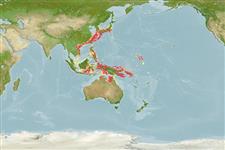>
Eupercaria/misc (Various families in series Eupercaria) >
Labridae (Wrasses)
Etymology: dewapyle: Name coming from the combination of the surnames of Mr Shin-ichi Dewa and Dr Richard L. Pyle, collectors of all type specimens; noun in apposition.
Eponymy: The binomial combines the surnames of the collectors of the type specimens: Shin-ichi Dewa (q.v.) and Richard L Pyle (q.v.) (Ref. 128868), visit book page.
Environment: milieu / climate zone / ລະດັບຄວາມເລິກ / distribution range
ນິເວດວິທະຍາ
ສັດທະເລ pelagic-neritic; ລະດັບຄວາມເລິກ 65 - 99 m (Ref. 105428), usually 65 - 70 m (Ref. 105428). Tropical; 20°C - 24°C
Western Pacific Ocean: from southern Japan (Iou-jima), Papua New Guinea and Fiji; including Indonesia.
ຂະໜາດ / ນ້ຳໜັກ / Age
ການຈະເລີນເຕັມໄວ: Lm ? range ? - ? cm
Max length : 5.6 cm SL ຕົວຜູ້/ບໍ່ມີເພດ; (Ref. 105428)
Short description
ຕົວທີ່ໃຊ້ໃນການຈຳແນກຊະນິດ | ສະລີລະວິທະຍາ | ການວັດແທກຮູບຮ່າງລັກສະນະພາຍນອກຂອງດິນ,ສັດ,ປາ…
ຄີ (ໜາມ)ແຂງຢູ່ຫຼັງປາ (ທັງໝົດ) : 10; ຄີຫຼັງຂອງປາ (ຄີອ່ອນ) (ທັງໝົດ) : 11; ຄີ(ໜາມ) ແຂງຢູ່ຄີກົ້ນປາ
ກຸ່ມປາກະດູກແຂງ
ຄວາມຖີ່ຂອງກຸ່ມຖ່າຍທອດພັນ
ປາທີ່ມີການເຄື່ອນຍ້າຍຈາກທະເລໄປຫານ້ຳຈືດ ແລະນ້ຳຈືດຫາທະເລ
ປາທີ່ມີການເຄື່ອນຍ້າຍຈາກທະເລແລະໄປໄຂ່ຢູ່ນ້ຳຈືດ
ຄີກົ້ນຂອງປາ
ສັດທີ່ມີກະດູກສັນຫັຼງ
ການຖ່າຍທອດທາງກຳມະພັນຈາກພໍ່ແມ່ຫາລູກ: 3; ຄີກົ້ນຂອງປາ: 12. This species is distinguished by the following set of characters: scale rows in longitudinal series 41-42 (mode 41); pored lateral-line scales 39-40 (39); gill rakers 12-13 (13); least distance between anteroventral margin of orbit and maxilla 1.2-3.7% (mean 2.5%) of SL; without red blotches superimposed and protruded on midlateral red stripe in adults and young; without yellow stripe on dorsal fin; the space between upper and midlateral red stripes vivid yellow; in young individuals, black blotch superimposed on midlateral red stripe on opercle, blotch fading with growth (Ref. 105428).
Body shape (shape guide): elongated; Cross section: oval.
An epibenthic species found on sandy, rubble and coral bottoms, with individual males sometimes
accompanied by a small harem (pers. comm. K. Nishiyama). It is most commonly seen at depths of 65-70 m during cold upwelling events (temperatures of 20-24C°) with adults observed to dive into the burrows of other organisms when startled, at Menjangan and Nusa Penida islands off Bali, Indonesia (Ref. 105428).
Life cycle and mating behavior
ການຈະເລີນເຕັມໄວ | ການສືບພັນ | ການວາງໄຂ່ | ໄຂ່ | ຄວາມດົກຂອງໄຂ່ປາ | ຕົວອ່ອນ
Fukui, Y. and H. Motomura, 2015. A new species of deepwater wrasse (Labridae: Terelabrus) from the western Pacific Ocean. Zootaxa 4040(5):559-568. (Ref. 105428)
IUCN Red List Status (Ref. 130435: Version 2025-1)
Threat to humans
Harmless
Human uses
ເຄື່ອງມື
Special reports
Download XML
ແຫຼ່ງອີນເຕີເນັດ
Estimates based on models
Phylogenetic diversity index (ເອກະສານອ້າງອີງ
82804): PD
50 = 0.6250 [Uniqueness, from 0.5 = low to 2.0 = high].
Bayesian length-weight: a=0.00490 (0.00204 - 0.01176), b=3.15 (2.94 - 3.36), in cm total length, based on LWR estimates for this (Sub)family-body shape (Ref.
93245).
ຊັ້ນເຂດຮ້ອນ (ເອກະສານອ້າງອີງ
69278): 3.3 ±0.4 se; based on size and trophs of closest relatives
ຄວາມຢືດຢຸ່ນ (ເອກະສານອ້າງອີງ
120179): ສູງ, ປະຊາກອນຕຳ່ສຸດທີ່ໃຊ້ເວລາສອງໜ້ອຍກວ່າ 15 ເດືອນ (Preliminary K or Fecundity.).
Fishing Vulnerability (Ref.
59153): Low vulnerability (10 of 100).
🛈
